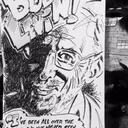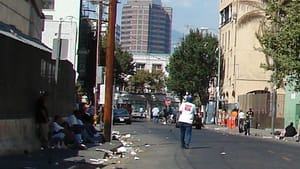Stay in the Loop
BSR publishes on a weekly schedule, with an email newsletter every Wednesday and Thursday morning. There’s no paywall, and subscribing is always free.
In Ghettoside, Jill Leovy uses the gang-related 2007 murder of 18-year-old Bryant Tennelle, in South Central Los Angeles as the starting point for a discussion of the nationwide epidemic of the murders of black men and boys. In nine cases out of ten, the murder is carried out by another black man or boy.
Leovy, a longtime Los Angeles Times reporter, argues that the epidemic is results from the centuries-long failure of the American justice system to act as though black lives matter. Los Angeles police, she writes, even had an acronym for these deaths: NHI (No Humans Involved). Blocked by racial prejudice from economic advancement and geographic mobility, inner city blacks were locked into isolated communities, like the Wild West, where the law was absent and the least offense led to blazing guns. The state’s failure to implement its proper “monopoly on violence” allowed this slaughter. “[W]here the criminal justice system fails to respond vigorously to violent injury and death,” she writes, “homicide becomes endemic.”
The statistics horrify. In the first years of the 21st century, the homicide rate for black men in their 20s was 48 times the average for all Americans. Today, for black men between the ages of 20 and 24, it is 20 to 30 times higher. In Los Angeles County, only slightly more than one-third of these homicides result in convictions. For non-fatal but serious physical injuries, the rate is 17 percent.
A superior police procedural
From Tennellle’s murder through the trial of his accused killers, Ghettoside unwinds as a superior police procedural. The search for suspects is minutely detailed. The questioning of the witnesses and suspects rings with authenticity. The trial and the post-trial interviews with jurors and others is compelling. And along the way, so context is not lost, bodies continue to pile up: Marquise Alexander (22); Drayvon James (21); Carnell Antoine (19); Dovon Harris (15); Da’Quan Allen (13); D’Angelo Beck (6). The uniqueness of their given names suggests a parental hope that, to their children, attention would be paid. Their ends, bleeding to death upon sidewalks, declares how badly this hope was misplaced.
Amidst this dark parade, certain personalities shine. Foremost is John Skaags, a gang detective, white and Republican-voting, devoted to working ghettoside streets. He is Leovy”s “hero,” if such a story can have one; but I was even more taken with Jessica Midkiff, a 22-year-old, hard-drinking, barely literate black prostitute, sexually abused as a child and drawn to men who abuse her still. Midkiff is Skaags’s key witness, and the question of whether she will survive to testify, let alone thereafter, and the relationship that develops between her and Skaags plucked deeper at my heart than the case itself.
Questionable solutions
Leovy’s reporting is faultless. Her outrage is apt. But her solutions — more detectives; more training and more resources; more arrests and more convictions — are questionable. I am all for convicting murderers, but putting aside the ancillary behavior that the exercise of state violence she calls for is likely to encourage, I wonder how effective having this monopoly in operation is likely to be. Capital punishment has never demonstrated it can deter capital crimes; why should life without parole?
At her book’s end, Leovy notes a recent “breathtaking decline” in L.A.’s homicide rate. She does not attribute this to a higher conviction rate; there hasn’t been one. Instead, she points to a decline in the city’s black population, an easing of residential segregation, and an increase in the availability of public benefits, particularly the expansion of Supplemental Security Income to cover men released from prison. The $800/month they get gives them independence and alters the risk/benefit ratio of actions they might otherwise take. “Autonomy,” Leovy concludes, “counters homicide.”
An alternative approach
This struck a responsive chord in me. When I was in VISTA on the south side of Chicago in 1967 and 1968, the primary organization to which I provided assistance was a multi-thousand member youth gang. At that time, Chicago youth gangs killed about 525 people annually, usually each other. There was a minority view, to which I subscribed, that, since traditional approaches, from social workers to gang intelligence units, had failed, the solution might be to capitalize on the size and discipline of these organizations, channel them into the political process, and hope they could become instruments for social change.
This view was not shared by the Chicago power structure — or for that matter, most adults in the neighborhoods where the gangs thrived. Their opposition led to a United States Senate investigation of an OEO-funded job training program — a key part of this new approach — that employed gang leaders as staff and gang members as trainees. The program was destroyed, though I would note that, as far as I can recall, no staff member, nor any trainee enrolled, was charged with a murder while it was in operation.
Chicago resumed addressing gang violence with the sticks of police batons and the carrots of midnight basketball games. At present, the grandchildren of the young men I knew are killing about 475 of each other annually. At this rate of progress, it will be the 26th century before the youth of Chicago will be lying down beside the lions and lambs.
You need, I think, to do more than jail people. If you put every murderer behind bars, but leave in place a society that brutalizes children so badly they become capable of killing while still a child, you have little to congratulate yourself for.
Author’s note: For a Mother Jones story on another intriguing approach toward reducing inner-city homicides, see here.
What, When, Where
Ghettoside: A True Story of Murder in America, by Jill Leovy. Spiegel & Grau, 2015. Available at Amazon.
Sign up for our newsletter
All of the week's new articles, all in one place. Sign up for the free weekly BSR newsletters, and don't miss a conversation.

 Bob Levin
Bob Levin
